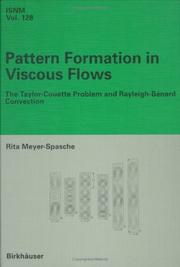| Listing 1 - 9 of 9 |
Sort by
|
Book
Year: 1988 Publisher: Cleveland, Ohio : NASA Lewis Research Center,
Abstract | Keywords | Export | Availability | Bookmark
 Loading...
Loading...Choose an application
- Reference Manager
- EndNote
- RefWorks (Direct export to RefWorks)
Fluid mechanics. --- Heat transfer. --- Interfacial tension. --- Microgravity. --- Rayleigh-Benard convection.
Book
Year: 1986 Publisher: Hampton, Va. : Institute for Computer Applications in Science and Engineering, NASA Langley Research Center,
Abstract | Keywords | Export | Availability | Bookmark
 Loading...
Loading...Choose an application
- Reference Manager
- EndNote
- RefWorks (Direct export to RefWorks)
Finite difference theory. --- Rayleigh-Benard convection. --- Simulation. --- Turbulence.

ISBN: 0521402042 9780521402040 Year: 1993 Publisher: Cambridge ; New York, NY : Cambridge University Press,
Abstract | Keywords | Export | Availability | Bookmark
 Loading...
Loading...Choose an application
- Reference Manager
- EndNote
- RefWorks (Direct export to RefWorks)
Bénard cells --- Nonlinear theories --- Rayleigh-Bénard convection --- Taylor vortices --- Théories non linéaires --- Rayleigh-Bénard, Convection de --- Bénard cells. --- Taylor vortices. --- Nonlinear theories. --- Bénard cells --- Rayleigh-Bénard convection --- Théories non linéaires --- Rayleigh-Bénard, Convection de

ISBN: 9810226578 Year: 1998 Volume: v. 11 Publisher: Singapore : World Scientific,
Abstract | Keywords | Export | Availability | Bookmark
 Loading...
Loading...Choose an application
- Reference Manager
- EndNote
- RefWorks (Direct export to RefWorks)
Rayleigh-Bénard convection. --- Rayleigh-Bénard, Convection de --- 532.517.4 --- Turbulent flow --- 532.517.4 Turbulent flow --- Rayleigh-Bénard convection. --- Rayleigh-Bénard, Convection de --- Rayleigh-Bénard convection --- Heat --- Bénard cells --- Convection --- Convection de Rayleigh-Bénard. --- Convection de Rayleigh-Bénard.

ISBN: 376436047X 081766047X 3034897383 3034887094 9783764360474 Year: 1999 Volume: 128 Publisher: Basel Birkhäuser
Abstract | Keywords | Export | Availability | Bookmark
 Loading...
Loading...Choose an application
- Reference Manager
- EndNote
- RefWorks (Direct export to RefWorks)
It seems doubtful whether we can expect to understand fully the instability of fluid flow without obtaining a mathematical representa tion of the motion of a fluid in some particular case in which instability can actually be ob served, so that a detailed comparison can be made between the results of analysis and those of experiment. - G.l. Taylor (1923) Though the equations of fluid dynamics are quite complicated, there are configurations which allow simple flow patterns as stationary solutions (e.g. flows between parallel plates or between rotating cylinders). These flow patterns can be obtained only in certain parameter regimes. For parameter values not in these regimes they cannot be obtained, mainly for two different reasons: • The mathematical existence of the solutions is parameter dependent; or • the solutions exist mathematically, but they are not stable. For finding stable steady states, two steps are required: the steady states have to be found and their stability has to be determined.
Viscous flow. --- Taylor vortices. --- Rayleigh-Benard convection. --- Pattern formation (Physical sciences) --- Rayleigh-Bénard convection --- Taylor vortices --- Viscous flow --- Fluid dynamics --- Viscosity --- Taylor-Couette flow --- Taylor vortex flow --- Vortices, Taylor --- Vortex-motion --- Heat --- Bénard cells --- Chaotic behavior in systems --- Convection --- Continuum physics. --- Mathematical models. --- Physics. --- Classical and Continuum Physics. --- Mathematical Modeling and Industrial Mathematics. --- Physics, general. --- Models, Mathematical --- Simulation methods --- Classical field theory --- Continuum physics --- Physics --- Continuum mechanics --- Natural philosophy --- Philosophy, Natural --- Physical sciences --- Dynamics
Book
ISBN: 0691212929 Year: 2020 Publisher: Princeton, NJ : Princeton University Press,
Abstract | Keywords | Export | Availability | Bookmark
 Loading...
Loading...Choose an application
- Reference Manager
- EndNote
- RefWorks (Direct export to RefWorks)
The synchronized flashing of fireflies at night. The spiraling patterns of an aggregating slime mold. The anastomosing network of army-ant trails. The coordinated movements of a school of fish. Researchers are finding in such patterns--phenomena that have fascinated naturalists for centuries--a fertile new approach to understanding biological systems: the study of self-organization. This book, a primer on self-organization in biological systems for students and other enthusiasts, introduces readers to the basic concepts and tools for studying self-organization and then examines numerous examples of self-organization in the natural world. Self-organization refers to diverse pattern formation processes in the physical and biological world, from sand grains assembling into rippled dunes to cells combining to create highly structured tissues to individual insects working to create sophisticated societies. What these diverse systems hold in common is the proximate means by which they acquire order and structure. In self-organizing systems, pattern at the global level emerges solely from interactions among lower-level components. Remarkably, even very complex structures result from the iteration of surprisingly simple behaviors performed by individuals relying on only local information. This striking conclusion suggests important lines of inquiry: To what degree is environmental rather than individual complexity responsible for group complexity? To what extent have widely differing organisms adopted similar, convergent strategies of pattern formation? How, specifically, has natural selection determined the rules governing interactions within biological systems? Broad in scope, thorough yet accessible, this book is a self-contained introduction to self-organization and complexity in biology--a field of study at the forefront of life sciences research.
Biological systems. --- Self-organizing systems. --- Adamson, J. --- Attenborough, David. --- Bagnoli, P. --- Buck, E. --- Bénard convection. --- Craig, W. --- Downing, H. A. --- Fick's Law. --- Franks, N. R. --- Grassé, P. P. --- Hanson, F. E. --- Heinrich, B. --- Jeanne, R. L. --- Kauffman, S. A. --- Luciola pupilla (firefly). --- Maruyama, M. --- Myerscough, M. R. --- Oecophylla sp. --- Pardi, L. --- Partridge, B. L. --- Schneirla, T. C., Turillazzi, S. --- decentralized control. --- electric fish electrolocation. --- evolutionary theories. --- inclusive fitness theory.
Book
ISBN: 9814560227 9814560235 Year: 2014 Publisher: Singapore : Springer Science,
Abstract | Keywords | Export | Availability | Bookmark
 Loading...
Loading...Choose an application
- Reference Manager
- EndNote
- RefWorks (Direct export to RefWorks)
This Brief addresses two issues of interest of turbulent Rayleigh-Bénard convection. The first issue is the characterization and understanding of the statistics of the velocity and temperature fluctuations in the system. The second issue is the revelation and understanding of the nature of the scaling behavior of the velocity temperature structure functions. The problem under the Oberbeck-Boussinesq approximation is formulated. The statistical tools, including probability density functions (PDF) and conditional statistics, for studying fluctuations are introduced, and implicit PDF formulae for fluctuations obeying certain statistical symmetries are derived. Applications of these PDF formulae to study the fluctuations in turbulent Rayleigh-Bénard convection are then discussed. The phenomenology of the different types of scaling behavior: the Bolgiano-Obhukov scaling behavior when buoyancy effects are significant and the Kolmogorov-Obukhov-Corrsin scaling behavior when they are not, is introduced. A crossover between the two types of scaling behavior is expected to occur at the Bolgiano length scale above which buoyancy is important. The experimental observations are reviewed. In the central region of the convective cell, the Kolmogorov-Obukhov-Corrsin scaling behavior has been observed. On the other hand, the Bolgiano-Obukhov scaling remains elusive only until recently. By studying the dependence of the conditional temperature structure functions on the locally averaged thermal dissipation rate, evidence for the Bolgiano-Obukhov scaling has recently been found near the bottom plate. The different behaviors observed in the two regions could be attributed to the different size of the Bolgiano scale. What physics determines the relative size of the Bolgiano scale remains to be understood. The Brief is concluded by a discussion of these outstanding issues.
Rayleigh-Bénard convection. --- Bénard cells. --- Bénard convection --- Bénard convection cells --- Engineering. --- Fluids. --- Thermodynamics. --- Heat engineering. --- Heat transfer. --- Mass transfer. --- Fluid mechanics. --- Engineering Fluid Dynamics. --- Engineering Thermodynamics, Heat and Mass Transfer. --- Fluid- and Aerodynamics. --- Heat --- Rayleigh-Bénard convection --- Bénard cells --- Convection --- Hydraulic engineering. --- Chemistry, Physical and theoretical --- Dynamics --- Mechanics --- Physics --- Heat-engines --- Quantum theory --- Construction --- Industrial arts --- Technology --- Engineering, Hydraulic --- Engineering --- Fluid mechanics --- Hydraulics --- Shore protection --- Hydrostatics --- Permeability --- Mass transport (Physics) --- Thermodynamics --- Transport theory --- Heat transfer --- Thermal transfer --- Transmission of heat --- Energy transfer --- Mechanical engineering --- Hydromechanics --- Continuum mechanics --- Rayleigh-Benard convection. --- Benard cells.
Book
Year: 2022 Publisher: Basel MDPI - Multidisciplinary Digital Publishing Institute
Abstract | Keywords | Export | Availability | Bookmark
 Loading...
Loading...Choose an application
- Reference Manager
- EndNote
- RefWorks (Direct export to RefWorks)
Flows of thermal origin and heat transfer problems are central in a variety of disciplines and industrial applications. The present book entitled Thermal Flows consists of a collection of studies by distinct investigators and research groups dealing with different types of flows relevant to both natural and technological contexts. Both reviews of the state-of-the-art and new theoretical, numerical and experimental investigations are presented, which illustrate the structure of these flows, their stability behavior, and the possible bifurcations to different patterns of symmetry and/or spatiotemporal regimes. Moreover, different categories of fluids are considered (liquid metals, gases, common fluids such as water and silicone oils, organic and inorganic transparent liquids, and nanofluids). This information is presented under the hope that it will serve as a new important resource for physicists, engineers and advanced students interested in the physics of non-isothermal fluid systems; fluid mechanics; environmental phenomena; meteorology; geophysics; and thermal, mechanical and materials engineering.
Research & information: general --- Physics --- coating flow --- free surface --- boundary layer --- stress singularity --- matched asymptotic expansions --- computational fluid dynamics --- turbulence --- rotating thermal convection --- Rayleigh–Bénard --- heat enhancement --- nanofluid --- circular pipe --- twisted tape --- porous media --- metal foam --- convection-driven dynamos --- numerical simulations --- bistability --- mean-field magnetohydrodynamics --- spherical shells --- stochastic equations --- equivalence of measures --- nature of turbulence --- critical Reynolds number --- thermovibrational convection --- gravity modulation --- thermofluid-dynamic distortions --- patterning behavior --- stratified mixing layer --- non-modal instability --- Kelvin-Helmholtz instability --- Holmboe instability --- rotating thermal magnetoconvection --- linear onset --- sphere --- Rayleigh–Bénard convection --- time periodical cooling --- Lattice Boltzmann method --- thermocapillary-driven convection --- half-zone liquid bridges --- particles --- coherent structures --- particle accumulation structure (PAS) --- high Prandtl number fluids --- plane layer --- circular translational vibrations --- thermal vibrational convection --- convective patterns --- n/a --- Rayleigh-Bénard --- Rayleigh-Bénard convection
Book
Year: 2022 Publisher: Basel MDPI - Multidisciplinary Digital Publishing Institute
Abstract | Keywords | Export | Availability | Bookmark
 Loading...
Loading...Choose an application
- Reference Manager
- EndNote
- RefWorks (Direct export to RefWorks)
Flows of thermal origin and heat transfer problems are central in a variety of disciplines and industrial applications. The present book entitled Thermal Flows consists of a collection of studies by distinct investigators and research groups dealing with different types of flows relevant to both natural and technological contexts. Both reviews of the state-of-the-art and new theoretical, numerical and experimental investigations are presented, which illustrate the structure of these flows, their stability behavior, and the possible bifurcations to different patterns of symmetry and/or spatiotemporal regimes. Moreover, different categories of fluids are considered (liquid metals, gases, common fluids such as water and silicone oils, organic and inorganic transparent liquids, and nanofluids). This information is presented under the hope that it will serve as a new important resource for physicists, engineers and advanced students interested in the physics of non-isothermal fluid systems; fluid mechanics; environmental phenomena; meteorology; geophysics; and thermal, mechanical and materials engineering.
coating flow --- free surface --- boundary layer --- stress singularity --- matched asymptotic expansions --- computational fluid dynamics --- turbulence --- rotating thermal convection --- Rayleigh–Bénard --- heat enhancement --- nanofluid --- circular pipe --- twisted tape --- porous media --- metal foam --- convection-driven dynamos --- numerical simulations --- bistability --- mean-field magnetohydrodynamics --- spherical shells --- stochastic equations --- equivalence of measures --- nature of turbulence --- critical Reynolds number --- thermovibrational convection --- gravity modulation --- thermofluid-dynamic distortions --- patterning behavior --- stratified mixing layer --- non-modal instability --- Kelvin-Helmholtz instability --- Holmboe instability --- rotating thermal magnetoconvection --- linear onset --- sphere --- Rayleigh–Bénard convection --- time periodical cooling --- Lattice Boltzmann method --- thermocapillary-driven convection --- half-zone liquid bridges --- particles --- coherent structures --- particle accumulation structure (PAS) --- high Prandtl number fluids --- plane layer --- circular translational vibrations --- thermal vibrational convection --- convective patterns --- n/a --- Rayleigh-Bénard --- Rayleigh-Bénard convection
| Listing 1 - 9 of 9 |
Sort by
|

 Search
Search Feedback
Feedback About UniCat
About UniCat  Help
Help News
News